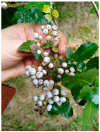In Vitro Inhibition of Enzymes and Antioxidant and Chemical Fingerprinting Characteristics of Azara serrata Ruiz & Pav. Fruits, an Endemic Plant of the Valdivian Forest of Chile
- PMID: 39409626
- PMCID: PMC11478526
- DOI: 10.3390/plants13192756
In Vitro Inhibition of Enzymes and Antioxidant and Chemical Fingerprinting Characteristics of Azara serrata Ruiz & Pav. Fruits, an Endemic Plant of the Valdivian Forest of Chile
Abstract
The World Health Organization has emphasized the importance of consuming small fruits for the prevention of chronic health problems, including diabetes, cardiovascular diseases, cancer, and obesity, which are named chronic non-communicable diseases (NCDs). Azara serrata Ruiz & Pav., commonly called "aroma de Castilla", is a shrub endemic to Chile from the Salicaceae family that produces an underutilized blue-grey berry that grows wild in southern Chile. The species is widely used as a medicinal plant by the Andean communities of southern Chile. In this work, a high-resolution mass spectrometric analysis of the methanolic extract revealed several phenolic compounds for the first time in the edible berry of this endemic species. Furthermore, several glycosylated anthocyanins were detected and quantified using UHPLC coupled with UV/Vis detection and trapped ion mobility mass spectrometry (UHPLC-DAD-TIMS-TOF) for the anthocyanin-rich extract, which was prepared using an optimized anthocyanin extraction protocol. The extract proved to be active in the inhibition of several enzymes linked to NCDs, such as acetylcholinesterase, tyrosinase, amylase, lipase, and glucosidase (IC50 = 3.92 ± 0.23, 12.24 ± 0.03, 11.12 ± 0.10, 32.43 ± 0.0, and 371.6 ± 0.0 μg/mL, respectively). Furthermore, the extract concentrated in anthocyanins showed good antioxidant activity evidenced by the bleaching of the radicals DPPH and ABTS, ferric-reducing antioxidant power (FRAP), and oxygen radical absorbance capacity (ORAC). The results show that these neglected endemic small berries can be a source of healthy phytochemicals. These Chilean berries can be used as functional food and their extracts are candidates for use as functional ingredients in naturally healthy products.
Keywords: TIMS-TOF; analytical membrane chromatography; anthocyanins; antioxidants; collision cross-section; corcolen; endemic berries; enzyme inhibition; pyrano anthocyanins; salicaceae.
Conflict of interest statement
The authors declare no conflicts of interest.
Figures












Similar articles
-
UHPLC-MS Phenolic Fingerprinting, Aorta Endothelium Relaxation Effect, Antioxidant, and Enzyme Inhibition Activities of Azara dentata Ruiz & Pav Berries.Foods. 2023 Feb 2;12(3):643. doi: 10.3390/foods12030643. Foods. 2023. PMID: 36766170 Free PMC article.
-
Anthocyanin characterization, total phenolic quantification and antioxidant features of some Chilean edible berry extracts.Molecules. 2014 Jul 28;19(8):10936-55. doi: 10.3390/molecules190810936. Molecules. 2014. PMID: 25072199 Free PMC article.
-
Chemical Fingerprinting and Biological Evaluation of the Endemic Chilean Fruit Greigia sphacelata (Ruiz and Pav.) Regel (Bromeliaceae) by UHPLC-PDA-Orbitrap-Mass Spectrometry.Molecules. 2020 Aug 17;25(16):3750. doi: 10.3390/molecules25163750. Molecules. 2020. PMID: 32824604 Free PMC article.
-
Anti-angiogenic, antioxidant, and anti-carcinogenic properties of a novel anthocyanin-rich berry extract formula.Biochemistry (Mosc). 2004 Jan;69(1):75-80, 1 p preceding 75. doi: 10.1023/b:biry.0000016355.19999.93. Biochemistry (Mosc). 2004. PMID: 14972022 Review.
-
Patagonian berries as native food and medicine.J Ethnopharmacol. 2019 Sep 15;241:111979. doi: 10.1016/j.jep.2019.111979. Epub 2019 May 30. J Ethnopharmacol. 2019. PMID: 31153864 Review.
Cited by
-
Influence of an Antioxidant Nanomaterial on Oral Tablet Formulation: Flow Properties and Critical Quality Attributes.Antioxidants (Basel). 2025 Jul 5;14(7):829. doi: 10.3390/antiox14070829. Antioxidants (Basel). 2025. PMID: 40722933 Free PMC article.
References
-
- Don D., Johnst I.M., Fundación R.A. Philippi de Estudios Naturales Santiago de Chile. [(accessed on 26 July 2024)]. Available online: https://fundacionphilippi.cl/catalogo/azara-petiolaris/
-
- Sagareishvili T.G., Alaniya M.D., Kemertelidze P. A new flavonol glycoside from Azara microphylla. Chem. Nat. Compd. 1983;19:275–278. doi: 10.1007/BF00579757. - DOI
-
- Giordano A., Retamal M., Leyton F., Martínez P., Bridi R., Velásquez P., Montenegro G. Bioactive polyphenols and antioxidant capacity of Azara petiolaris and Azara integrifolia Honeys. CyTA—J. Food. 2018;16:484–489. doi: 10.1080/19476337.2018.1426631. - DOI
Grants and funding
LinkOut - more resources
Full Text Sources
Miscellaneous

